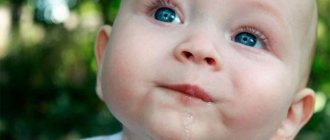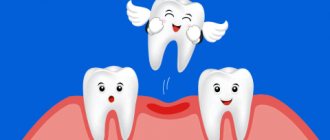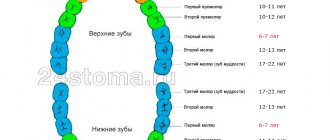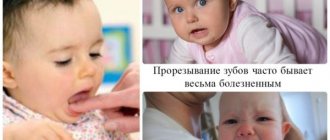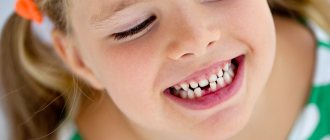The period when a baby's baby teeth erupt is both exciting and difficult for both the child and his parents. Children are often capricious during this period, sleep poorly, cry, and all because the appearance of their first teeth is accompanied by unpleasant sensations. Since the child himself cannot tell his parents about his problem and always reacts the same way to any type of discomfort, it is difficult for mom and dad to differentiate the signs of teething under the child’s behavior.
In this article, especially for young parents, we have collected as much useful information as possible about the eruption of baby and permanent teeth in children, so that you understand what is happening and how to act in this situation to help the baby.
When and what teeth do children erupt?
In fact, the rudiments of baby teeth are formed in children even during the period of embryonic development, and at the moment when they begin to grow and erupt, the rudiments of permanent teeth are already being prepared in the child’s jaw to replace them.
If we talk about the “gold standard”, then the teething scheme looks like this:
- 6-8 months – two central lower incisors.
- At approximately 8 months, the upper central incisors also appear.
- At 8-12 months, the upper lateral incisors appear.
- Around the same time (10-12 months), the lower lateral incisors erupt.
- At 14-20 months, the first chewing teeth appear on the lower and upper jaws (one on each side - 4 in total).
- At 1.5-2 years, the first canines erupt in the upper and lower dentition.
- At the age of 2-3 years, the following chewing teeth appear.
Despite the specified timing, each baby has his own individual teething order. So, some babies show their first teeth at 4.5 months, while others are “delayed” and, on the contrary, grow a little later than the established age. Such features depend on many factors, including gender (usually girls take the lead in teething).
Timing and order of teething in children -
The first teeth erupt in a child normally, starting from 5-6 months. The very first tooth (or rather a pair of teeth) that a child appears are the central incisors of the lower jaw. In some cases, this can happen several months earlier - including even in the first month of the child’s life. The reasons for premature teething have not yet been established, but it certainly negatively affects the health of baby teeth, contributing to their early carious lesions.
In this case, the development of the enamel structures of the tooth crown and their mineralization have not yet reached a certain degree - as a result, tooth enamel is more vulnerable to cariogenic microorganisms and the acids they secrete. Therefore, if your child has premature teething, then ideal oral hygiene is needed, as well as mandatory adherence to a number of recommendations on nutrition and feeding regimen. Ideally, a course of remineralization of teeth can be carried out, which will further increase their resistance to caries.
With normal development of the child, the timing of teething corresponds to what you can find in diagrams 1 and 2. A slight delay should not cause any alarm, however, a delay of 3-4 or more months - in some cases, may indicate a violation of the child’s physical development, metabolic disorders or the presence of a general somatic disease. Also, a delay in teething in children may be associated with the health of the mother and the influence of adverse factors on the fetus during pregnancy.
Formation of milk bite
The process of building a human bite has 5 stages, and all of them occur in childhood.
Each of the five stages is important for the final formation of the entire dental system and dental occlusion:
The first stage is from birth to 6 months (before the appearance of the first teeth).
The second stage is the period of eruption of all baby teeth in a child (6 months - 3 years).
The third stage is the period of jaw growth, preparation for the natural change of milk teeth to permanent ones (3-6 years).
The fourth stage is the time of active growth of the jaws and the eruption of permanent teeth (6-12 years).
The fifth stage is 12-15 years old, when the child’s baby teeth have already changed and all teeth are permanent.
Correct formation of the primary dentition is one of the main conditions for the development of a correct permanent dentition in a child.
Symptoms of baby teeth erupting
Each baby reacts individually to the eruption of baby teeth, however, there are characteristic symptoms by which parents can understand that this is happening:
- heavy salivation;
- redness and swelling of the gums;
- itching
Severe itching and sometimes even painful sensations make the child capricious. He becomes restless, which disrupts his sleep. To somehow relieve the itching, children put toys in their mouths and intensively rub their gums. Children often refuse to eat or eat with less appetite. What does the gum look like when teeth come in? Changes in the condition of the gums are one of the criteria by which parents can differentiate teething. The gums in this place look inflamed - they turn red, swell, and immediately at the site of tooth eruption they become white.
However, the biggest concerns about the child’s condition are cough, runny nose, and fever during teething. Indeed, the appearance of baby teeth in its symptoms can resemble colds, and it is difficult for parents without experience to understand whether the baby is sick or is just teething.
First of all, you need to understand that both fever and cough during teething in children are acceptable reactions. Cough, hoarseness, and runny nose are most often the result of excessive salivation. For the same reason, during teething, babies develop a rash on the chin and around the mouth.
Another frequently asked question from parents is what kind of stool can a child have when teething? During a particularly acute period of teething, babies may have weak stools, which is associated with general irritation of the nervous system and has nothing to do with eating disorders.
However, it must be taken into account that when babies are teething, they are more susceptible than usual to various infections. If unpleasant symptoms (fever, diarrhea, cough) do not go away on their own after 2-3 days, the child should be examined by a doctor.
How long does teething take for babies?
With normal development and growth, baby teeth erupt within a few days (2-8 days), and the most unpleasant symptoms usually appear within about 2 days.
The period of formation of the primary occlusion ends at 2-3 years, and at this moment the baby has 20 primary teeth.
Problems and complications when the first teeth appear
Sore gums, fever, poor appetite and indigestion are, although unpleasant, acceptable symptoms during the eruption of baby teeth.
In some cases, children experience complications:
- long delay - can be either a genetic feature or pathological adentia (if the child has not formed the rudiments of teeth);
- formation of a hematoma (cyst) - in this case, the gum above the growing tooth acquires a dark purple tint, then a lump or hematoma appears in this place, which may be due to both difficult eruption (the tooth cannot cope with the mucous membrane) and other reasons;
- violation of the order of teething;
- aphthous stomatitis - rashes on the mucous membrane in the form of purulent ulcers;
- enamel hypoplasia – occurs in babies under 10 months of age;
- malocclusion - improper closure of teeth, crowding, possible problems with the eruption of permanent teeth in the future.
If your baby experiences “difficult eruption” of primary teeth or you encounter the listed complications, you should definitely consult a pediatrician. If the formation of a primary occlusion is clearly incorrect, consult an orthodontist.
What to do when teething: advice for young parents
Now that you know what is happening to your child, you can draw up a rough action plan aimed at making the process of the appearance of the first teeth as easy as possible for the baby.
Tips for moms and dads:
- 1
Stay calm. It’s not easy for a child anyway, and your anxiety and irritation will only negatively affect the baby’s well-being. - 2
Surround your baby with love and tenderness. Remember that small children feel calm and safe only in the arms of loving parents.
- 3
Provide your baby with special gum toys that will help relieve itching and make teething easier.
- 4
Turn on the increased antibacterial protection mode (frequent ventilation, sterilization of toys, pacifiers, etc.), since during this period the child can easily catch an infection.
If your baby's gums are bothering you a lot, you can use a special teething gel. This product has a mild anesthetic effect, relieves itching and pain. Regarding the choice of gel, it is better to consult your pediatrician. He will tell you which drug is suitable for your baby’s age and has a safe composition.
What to do when the temperature rises? Doctors recommend avoiding the use of antipyretic drugs, as the body fights infections by raising the temperature. If hyperthermia is very high, you should consult a pediatrician, he will recommend what medications and in what dosage can be given to the baby. Under no circumstances use folk remedies or medications without first consulting a doctor!
How to help your child with medicine when teething
For some children, homemade recipes and other non-drug methods do not help. This is due to the different sensitivity and susceptibility of the body of small patients. All medications should be selected exclusively by a doctor. It is likely that the infant has a history of chronic and other diseases for which drug therapy is strictly contraindicated. Self-prescription of pharmaceutical products can lead to allergic reactions and other side effects, so it is better not to rely on reviews on the Internet and advice from other mothers. Let's look at how to help a child teething with the help of medications.
Kalgel
The combined gel has an anesthetic and anti-inflammatory effect. The active ingredient is lidocaine, that is, inflamed and swollen gums seem to be “frozen.” Sold exclusively with a doctor's prescription. It is necessary to observe the exact dosage and avoid excessive use. The effect lasts for a long time.
Kamistad
Produced in Germany. The principle is almost identical to the previous drug, but the composition contains harmless polidocanol and tincture of chamomile flowers. Herbal components help eliminate pain, itching, inflammation, swelling and redness. The composition is sweet, so the little patient will not spit it out and will be happy to open his mouth. It is often prescribed by doctors for diseases of the oral cavity.
Holisal
The gel-like substance contains choline salicylate and auxiliary components. Prescribed also for adults. Allowed for use over six months of age. It acts quickly and relieves a wide range of dental problems. This is one of the best remedies for pain relief when a child is teething badly. The disadvantage is the higher cost compared to analogues.
Dentinox
A paste based on lidocaine and chamomile extract disinfects treated surfaces of the oral cavity, relieves pain and swelling of soft tissues. Unpleasant sensations are eliminated in a short period of time, the baby sleeps soundly, does not cry for no reason, and happily eats mother's milk or an adapted formula from a bottle. Since the gel is applied externally, it is completely safe when used in moderation.
Formation of permanent bite
The development of permanent teeth is a long and complex process. The formation of permanent teeth begins at approximately 3 years of age, when the child’s primary bite is already fully formed.
Preparations for their eruption are ongoing, but changes occur gradually, so most often we don’t even notice them. Meanwhile, the child:
- jaws grow and expand;
- the distance between baby teeth increases (this is important, since permanent teeth are larger and by the time they erupt there should be enough space for them in the dentition).
Timing of eruption of permanent teeth in children
The order of growth of permanent teeth in children is mainly hereditary. In approximately 50% of cases, the molars (sixes) grow first. Second molars appear at 7-8 years of age. Around the same time, the incisors are replaced.
The first permanent tooth appears in children at 6 years of age, and the complete formation of the permanent dentition of the lower and upper jaw is completed at 12-13 years of age. After this, the roots of permanent teeth continue to form and this process ends by the age of 15.
Teething symptoms
Unlike baby teeth, permanent teeth in children erupt almost always painlessly and with virtually no symptoms.
In rare cases, during the teething period the child’s well-being may deteriorate:
- the child gets tired quickly;
- drowsiness appears;
- gums become inflamed;
- salivation increases, a runny nose appears;
- The gums itch where the tooth grows, and when chewing, painful sensations appear.
Problematic eruption of permanent teeth in children
Problems that may arise during the eruption of permanent (molar) teeth:
- 1
Growth retardation – after a baby tooth falls out, the permanent one is in no hurry to appear for 6 months or longer.
- 2
Bite pathology. It may be associated with premature eruption of permanent teeth (if the baby teeth have not yet fallen out), or lack of space on the jaw for normal tooth growth.
- 3
Hyperdentia - permanent teeth grow second row behind the milk teeth. The reason is the strong fixation of the temporary tooth in the socket, as a result of which the permanent tooth “chooses” a more convenient direction for growth.
- 4
Caries and its complications.
What you need to know about deadlines
With the correct development of the newborn’s body, teething occurs at certain times according to the principle of pairing. Usually identical teeth erupt at the same time - this applies to pairs of central and lateral incisors and canines.
At birth, there are 20 follicles in both jaws of the baby - 10 for each jaw, which are the rudiments of temporary teeth. The newborn also has 16 permanent tooth buds. Another 16 primordia begin to form after birth.
The order of eruption of baby teeth:
Important:
Here are the average dates for teething in newborns. However, the development of each organism is strictly individual, so it is possible that these dates may shift in one direction or another in approximately 50% of cases. Therefore, do not panic if deviations from the given deadlines are insignificant.
There are cases when a baby was born with the first tooth. This makes breastfeeding much more difficult, so you need to get appropriate advice from your doctor.
With artificial feeding, there may be a delay in teething, while a breastfed baby's teeth erupt earlier in 10 cases out of a hundred. In addition, the delay in the eruption of baby teeth is influenced by the condition of the mother during pregnancy - for example, toxicosis, infectious diseases, stress, as well as diseases suffered by the baby.
How to help your child: recommendations from Amel Dental doctors
To cope with the discomfort caused by the eruption of permanent teeth, it is enough to massage the child’s gums. If your gums are inflamed, a teething gel will help relieve the inflammation (your dentist will help you choose the right one).
What to do if complications develop?
- 1
Bite problems in children are easier to eliminate than in adults, so if there are defects, you should consult an orthodontist.
- 2
Caries requires immediate treatment, otherwise there is a chance that the child will lose a tooth in childhood.
- 3
If dental growth is delayed, you should immediately see a doctor. One of the main reasons for delayed eruption of permanent teeth in children is immune disorders.
How to relieve symptoms
The basic principle of medicine is to do no harm. Therefore, the first thing you need to do is consult a doctor. You cannot select medications on your own or on the advice of neighbors. And in the pharmacy you can find a lot of ointments and gels with a “cooling” effect and remedies for fever.
Teethers
There are different types of devices. Some of them are used for signs of eruption of the upper teeth, others are suitable for the frontal units or distant molars. The purpose of use is to massage the gums, which alleviates the condition of the little one. You can buy silicone and latex products that are suitable for children as young as 3 months. If mom will massage her gums, she needs a fingertip with a special brush. To help the baby scratch his teeth and play at the same time, special rattles have been created. Teethers for yearlings can be filled with gel or water. They cool the oral cavity well, which “freezes” the pain. The device may vibrate if the baby bites it.
Cream
It is used as a protective agent at the time of increased salivation. This protects the skin of the chin and chest from irritation, especially during a walk in winter.
Vertical position
Parents need to play with their baby more often and distract him from pain. Holding your child upright will reduce pain by reducing blood flow to the head.
Drinking regime
Salivation, especially increased salivation, provokes severe thirst. You need to give your baby more clean water.
Psychological discomfort is compensated by affection, care, and attention. At this time, you should not introduce new foods into the diet, so as not to expose the baby to additional stress.
How to keep children's primary and permanent teeth healthy?
Both baby and molar teeth of a child require careful care. The health of future permanent teeth depends on how healthy the child's baby teeth were. The main concern of parents is quality care, timely treatment and preservation of baby teeth until the time comes for their natural replacement with permanent ones.
What should you do for this?
- Carefully monitor the condition of your baby’s teeth and regularly take him for examinations to the dentist in order to diagnose caries in time.
Prevention of caries is one of the main conditions for the health of a child’s future permanent teeth. You can protect your teeth by ensuring regular high-quality oral hygiene. One of the most effective measures to prevent caries in children is the dental procedure of sealing the fissures of baby teeth.
- Treat caries in a timely manner.
Unfortunately, temporary teeth have very thin enamel and not a very dense structure, so when affected by a carious infection, they are quickly destroyed. With timely diagnosis, caries is treated quickly and without complications - in dentistry, baby teeth are filled with safe materials. Thanks to modern materials and technologies in dentistry, it is even possible to restore baby teeth with severe destruction. In some cases, if the baby tooth could not be saved, and there is still a lot of time left before the permanent teeth erupt, prosthetics of temporary teeth is used.
- Take care of proper nutrition.
Food is an important source of useful vitamins and microelements, so it is important that the child’s diet is varied and balanced.
Both baby and molar teeth of a child require careful care. The habit of brushing teeth and observing the rules of oral hygiene is formed in children from the appearance of their first teeth. Maintaining the health of children's teeth requires very little time and effort, but all this effort will help your child keep his teeth healthy for a long time!

